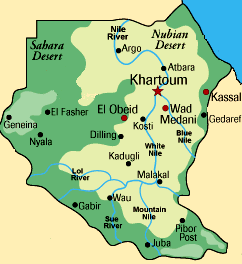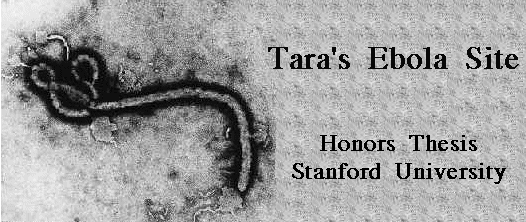Ebola Sudan Outbreaks

- 1976. Nzara and Maridi, Sudan.
The first case of Ebola-Sudan (EBO-S) was first detected in Nzara, Sudan and
then spread to Maridi, Tembura, and Juba. On June 27, 1976, a Nzara Cotton
Manufacturing Factory cloth room worker, YuG, became ill with a hemorrhagic
febrile disease, Ebola hemorrhagic fever (EHF), and died in the Nzara hospital
on July 6, 1976. The second primary case of EHF was a man, Bz, who also worked
in the cloth room and died in the hospital on July 14. Bz's wife, who nursed
him during his illness, suffered a fatal case of Ebola hemorrhagic fever.
The epidemiologically most important primary case, PG, who worked alongside
YuG and Bz, became ill on July 18 and died on July 27 after several short
stays in the Nzara hospital. 69% of all the EHF cases in Nzara and the introduction
to Maridi and Tembura were traced to PG. The World Health Organization (WHO)
investigators reported observing direct person-to-person transmission of EBO-S
through six generations of EHF cases traced back to PG.
References:
- WHO Study Team. "Ebola haemorrhagic fever in Sudan, 1976." Bulletin
of the World Health Organization, 56 (2): 247-270 (1978).
- 1979. Nzara, Sudan.
On 2 August 1979, a 45 year-old man was admitted to the Nzara hospital with
a fever that had lasted for three days and recent onset of diarrhea and vomiting.
While at the Nzara hospital, he developed gastrointestinal hemorrhaging and
died on August 5. The Nzara hospital was poorly stocked, and the hospital
staff had not taken precautionary isolation measures or practiced barrier
nursing techniques. The hospital did not learn until several weeks after the
patient's death that three of his relatives who had cared for him during his
illness had developed hemorrhagic fever and subsequently died in the family
compound. Later in August, several people in a second family developed hemorrhagic
fever and were hospitalized, and an outbreak was identified. The district
was quarantined and was under regional surveillance in early September. After
two Nzara hospital nurses had died of HF, WHO sponsored a team on September
22nd to contain the outbreak. During this outbreak, there were 34 people infected
with a 65% case fatality rate. Every case had direct links to the index case
who was employed at the Nzara Cotton Manufacturing Factory.
References:
- Baron, R.C. et al. "Ebola virus disease in southern Sudan: hospital
dissemination and intrafamilial spread." Bulletin of the World
Health Organization, 61 (6): 997-1003 (1983).
©1999 Tara Waterman


